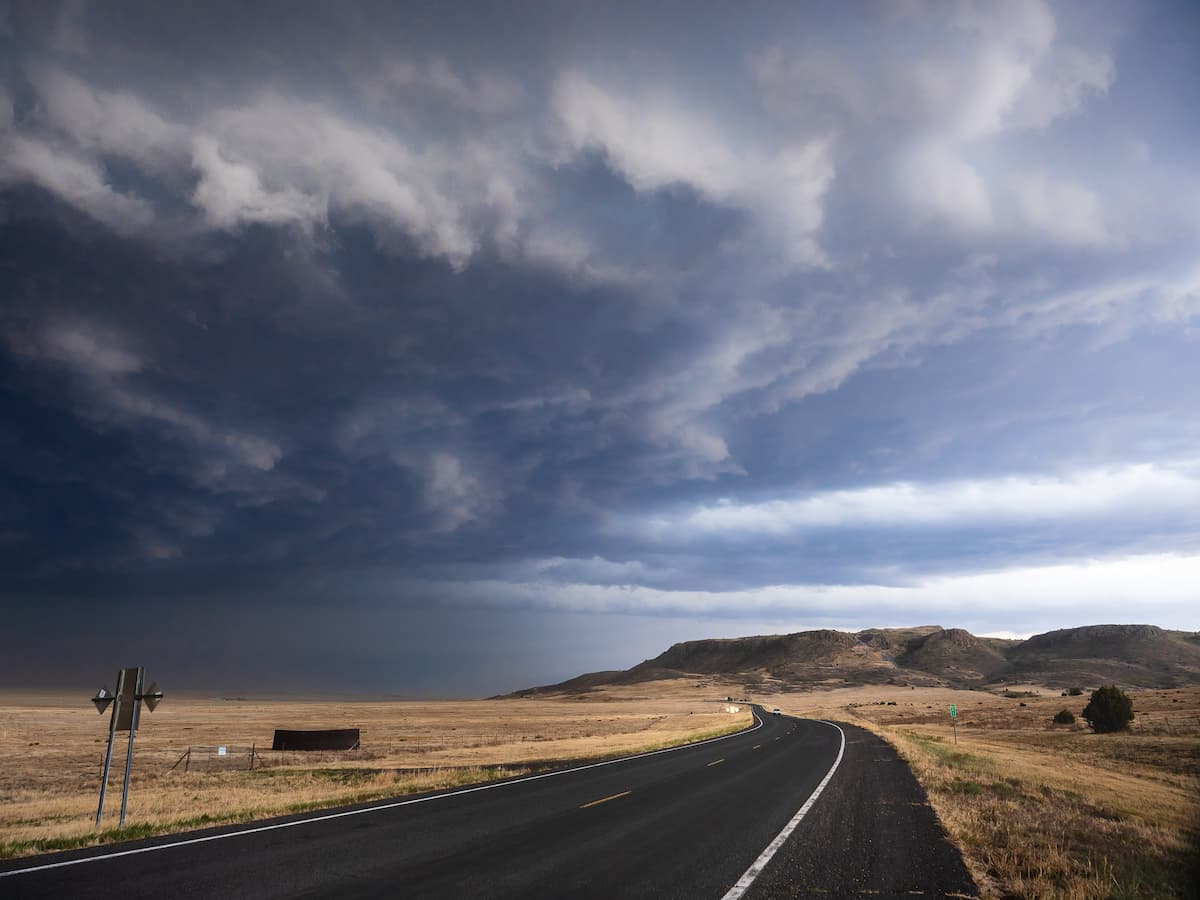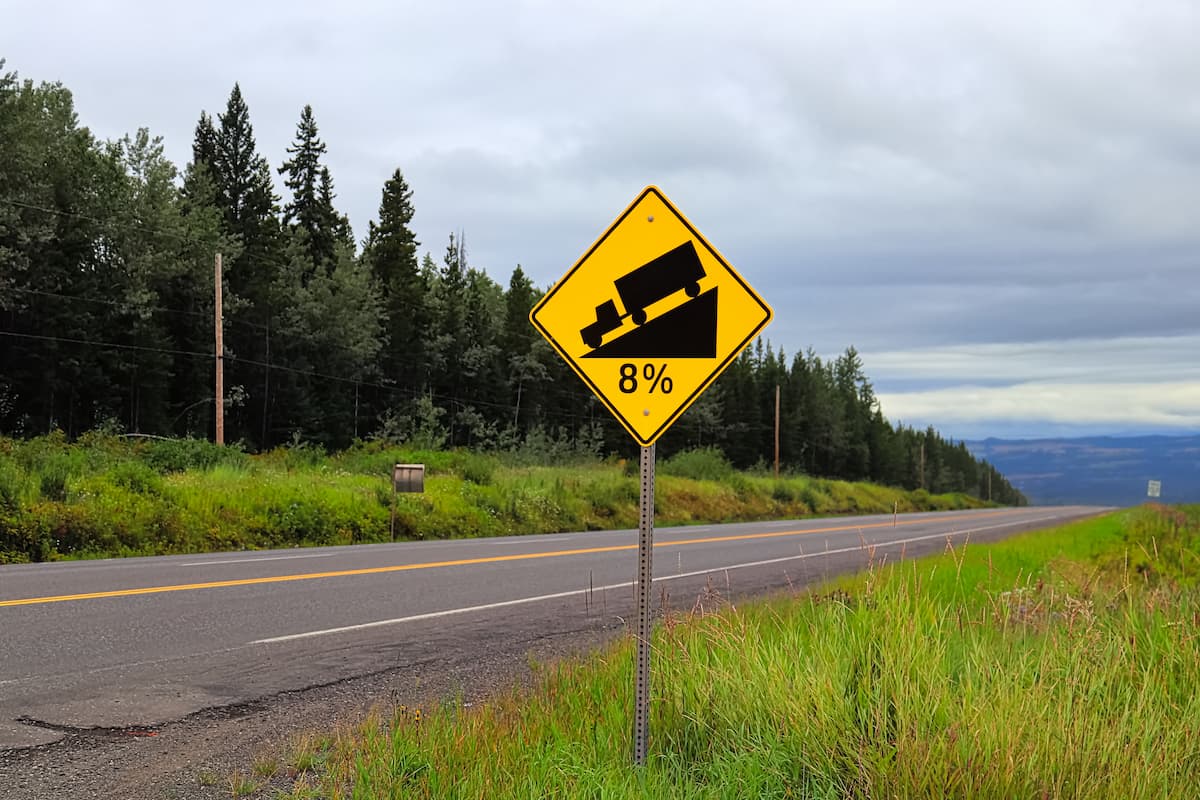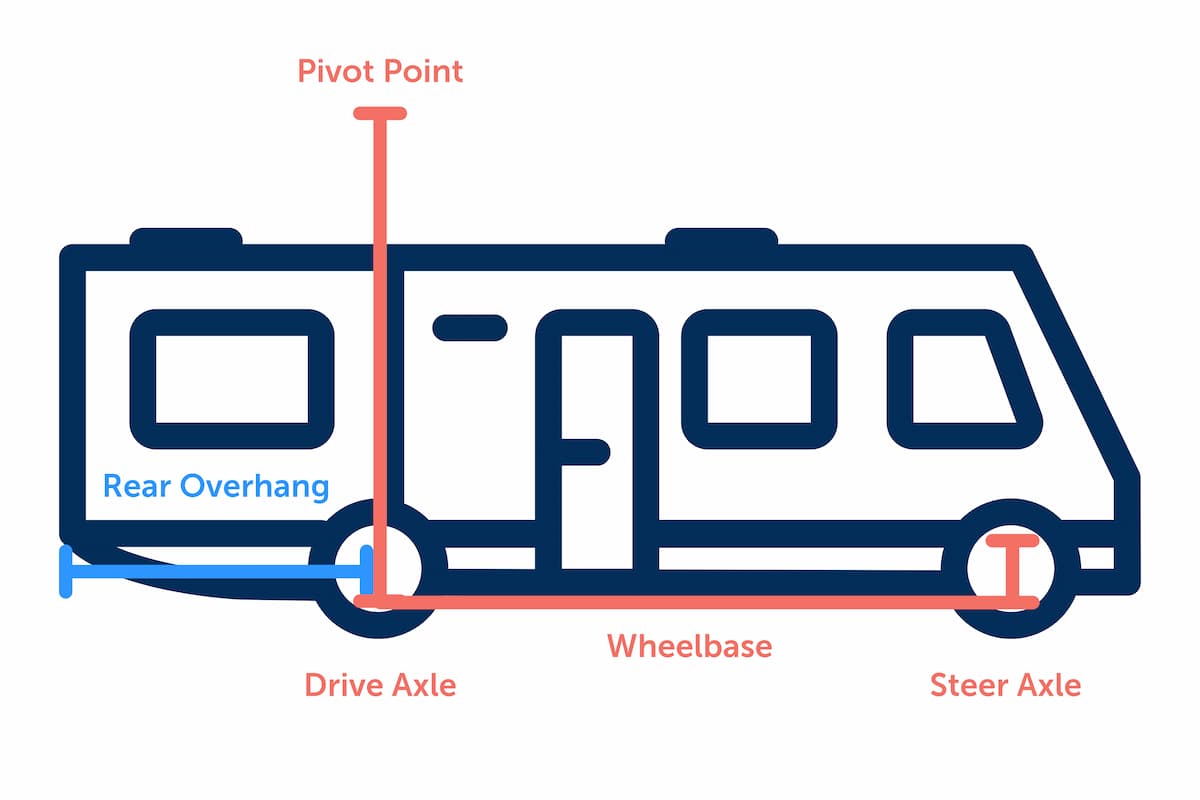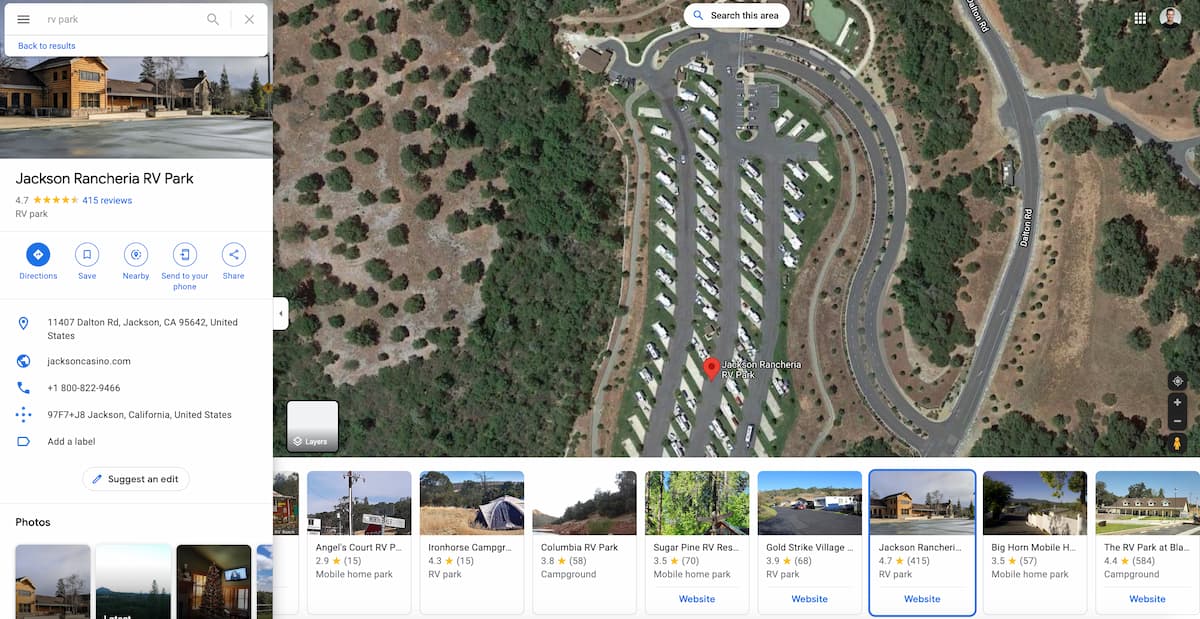![12 Simple Tips for Driving Large RVs [Videos & Infographic]](https://ghost-cdn.rvezy.com/2021/07/rv-driving-tips.jpg)
Driving an RV can feel intimidating, even for experienced drivers. The good news is that you won’t always feel apprehensive. Learning to feel comfortable behind the wheel takes practice and time.
Even though these RV driving tips are tailored for driving motorized RVs, most of them will help you when pulling a travel trailer, too.
RVezy pro tip: Not sure which RV is best for a new RVer? Check out The Best RVs for First-Time Owners & Renters.
Whether you are looking for driving tips for your new RV or you’re preparing for your first RV rental road trip, these 12 tips for driving an RV will help you feel more confident.
Buckle up! It’s time to roll!
Walk around the RV
Did you know that a simple oversight, such as forgetting to retract the steps or the awning, can lead to a costly insurance claim?
Every time you get ready to drive, walk around the outside of the RV. It doesn’t matter whether you’ve parked for the night or stopped for gas; make it a habit to check everything from top to bottom.
- Watch for potential obstacles such as trees, electrical boxes, campground hoses, or other RVs.
- Disconnect your water, sewer, and electricity.
- Stow and secure your camping equipment.
- Check that the storage bays are closed and locked. Unlocked bays can open during travel.
- Close your awnings, windows, vents, and retractable stairs.
- Inspect your tires for visible cracks, bulges, or uneven wear.
- Look under the RV to check for retracted jacks and make sure no objects or animals lie underneath your unit.
- Check the pins and connection points on your tow vehicle or trailer.
- Clean your windshield if bugs or dirt impair your field of view.
- Remove any items hanging from the RV.
- Secure any loose equipment inside and outside of the RV.
- Pick up your wheel chocks.
Adjust and get comfortable
Preparing for a long drive? Get comfy!
Before you pull out of the driveway, take time to adjust your seat, mirrors, and steering wheel and familiarize yourself with any rear or blind spot cameras. Ensure you have a good view from every angle. Large RVs have cameras that can help you see what’s happening behind and along both sides of the rig while driving.
Don’t worry If your mirrors or cameras need some adjusting while you are driving. If that happens, find a safe place, like a rest stop or picnic area, to pull over and readjust.
Enjoy the ride
Taking a road trip? Slow down and enjoy the ride! Just because you can drive your RV 85 mph (135 km/h) doesn't mean you should. RVs and trailers carry a lot of weight, especially when they’re loaded with water. The heavier the RV, the longer it will take to come to a stop. Driving at a reasonable speed will help keep you and your passengers safe.
Did you know that some states, provinces, and territories have different speed limit laws for RVs and travel trailers?
Driving an RV requires concentration. The key to a successful RV road trip is to operate within your comfort zone. Less is more when you drive an RV. A good rule of thumb is to drive no more than 330 miles (530 kilometres) in a day and arrive at your campground before 3:30 p.m. It’s easier to navigate your RV and set up camp before it gets dark.
Renting an RV? Think about adding a second driver to your rental before hitting the road. Switching drivers helps with fatigue, and when you rent an RV, anyone who takes the wheel must be an approved driver.
Monitor the weather and road conditions
“Weather and construction delays are fun,” said no RVer ever.

While it’s impossible to avoid storms or traffic completely, RVers can help reduce road-related delays by using road trip apps for monitoring the weather and road conditions. Before you get in the RV, check the weather between your current location and your destination. If wind or a potential storm might impact your drive, adjust your route or leave at a different time to avoid potentially hazardous weather.
Did you know that several states use Twitter to update travelers on current road conditions? The Colorado Department of Transportation, Oregon Department of Transportation, and Tennessee Department of Transportation all use Twitter to send out traffic alerts. While you are driving, have your co-pilot use Twitter or another app like Waze to monitor accidents and delays and help you find an alternate RV-friendly route.
Know your RV’s dimensions
Grab a sticky note and a pen. It’s time to decorate your dashboard with something practical — your RV’s dimensions.

Measure your RV’s dimensions and use a laminated card or sticky note placed on your dashboard to display your rig’s height, length, and width. Attempting to drive under a low-clearance area will not only destroy your RV but could also damage the overpass or bridge’s infrastructure.
RVezy hosts and guests tip: Traveling between Canada and the United States? Convert the units of measurement and display your RV’s dimensions using both feet and metres.
You can avoid low-clearance areas by using the RV Life Pro app or an RV-aware GPS unit. However, even with technology, drivers should know and display their RV’s dimensions because in a pinch, will you be able to recall those measurements quickly?
Go slowly on inclines, downgrades, and mountain passes
Driving an RV on an incline, downgrade, or curvy mountain pass is different from driving an RV in a straight line. Although you might want to get the hilly part of your drive over quickly, your best bet is to go slowly. Driving too fast or overexerting your engine or brakes could lead to overheating.

Review your driving directions
- Review your route each day before starting your drive.
- Be aware of inclines, downgrades, and mountain passes, and change your route if you’re not comfortable with the road conditions.
- Be mindful of any height, weight, or length restrictions before attempting to drive a mountain pass.
Climbing a hill
- Slow down and downshift so the engine can help you climb the hill without overheating.
- Stay in the right lane and let faster vehicles pass you.
Should you use your hazard lights when your RV can’t keep up with the flow of traffic? Every state and province has different rules for using hazards. Familiarize yourself with hazard laws before driving.
Going downhill
- Downshift before you start to go downhill.
- Use your engine and transmission to help slow your speed when going downhill.
- Use the tow/haul mode if equipped.
- Hard braking for shorter periods is better than soft braking for long periods.
- Slow down. Follow the posted speeds at each curve or turn.
Familiarize yourself with the RV’s mechanics

Off-tracking. When the rear wheels follow a different path than the front wheels. The longer the wheelbase and the sharper the wheel cut, the greater the off-tracking.
Wheelbase. The space between the steer and drive axles. Everything behind the drive axle is part of the rear overhang.
Steer axle. The front axle.
Wheel cut. The angle the wheels on the steer axle will turn in either direction. Higher wheel-cut angles have less of a turning radius.
Drive axle. The rear axle and the turning pivot point.
Rear overhang. The part of the RV that sticks out behind the drive axle.
Tail swing. When the rear overhang swings in the opposite direction of your turn. If you turn to the right, the rear overhang swings to the left.
Putting the mechanics into motion
It’s essential to understand how an RV turns. All vehicles have some level of off-tracking during a turn. In an RV, the off-tracking is more pronounced because of the longer wheelbase and tighter turning radius.
In addition to off-tracking, an RV’s rear overhang swings in the opposite direction of the turn. The more the tail swings, the more aware you’ll need to be when making turns.
Once you understand how your rear overhang moves, you’ll be able to adjust your turns to avoid hopping a curb or hitting something with the rear overhang.
RV driving tips to help manage turns and tail swing
- Get ahead of an obstacle before turning to avoid hitting something with the rear overhang.
- Avoid making sharp turns.
- Leave extra space in front of your RV when you're parking alongside a gas pump or other obstacle. It’s better to pull forward before your turn than to turn sharply.
- Wait for cars to move when you need to use part of another lane during a turn. It’s better to wait for an opening than to jump a curb or hit another vehicle.
Find RV-friendly fuel stations
In a perfect world, all RV-friendly fuel stations would look and operate like Buc-ees.
Since big RVs and small fuel stations don’t mix well, and only a few states have Buc-ees, RVers need a different way to find fuel stops that accommodate large RVs.
The Next Exit is an excellent resource for RVers who drive interstate highways within the United States. The Next Exit gives drivers an overview of gas stations, restaurants, hotels, and shopping at each exit and highlights the RV-friendly fuel stations in red.

Another option for RVers is to use an app for locating the RV-friendly truck stops like Pilot Flying J and Love’s. The GasBuddy app finds fuel stations near your location and provides updated fuel prices as well as fuel discounts. Other apps like AllStays and RV Life also have search features that help RVers locate the closest gas station.
Check out an aerial view
Have you ever taken a detour on a road trip because you saw a billboard advertising the world’s best burgers?
Like all road trippers, RVers get hankerings, but we have to be more selective about where we stop and park because of the size of our vehicles. To avoid a tight turnaround or a car full of disappointed kids, use Google Maps satellite view to see an aerial view of a parking lot.
Google Maps is also a helpful tool for boondockers. After finding a free place to camp, just switch to satellite view to see an aerial view of your potential campsite.

Do you own a drone? Drones work the same way as satellite view, but they can help you scope out a campsite in real time. Many boondockers use drones to check if the terrain is safe or find a spot away from other campers.
Before flying a drone in the United States, make sure you understand the rules for flying an unmanned aircraft in the U.S. The Federal Aviation Administration (FAA) publishes drone guidelines on its website. Canadian campers who want to fly drones should visit Transport Canada for drone-flying guidelines.
Book campsites with pull-through driveways
Driving an RV takes practice, and practice makes perfect.
Backing up a motorhome or trailer can be challenging if you’ve not done it before. Thankfully, you don’t have to back up your RV at the campground unless you want to.
The easiest RV driving tip to follow on this list probably alleviates one of the biggest newbie RVer fears — backing into a campsite. Until you become more comfortable backing up your RV, choose campsites with large, pull-through driveways. Even experienced RVers like campsites with pull-through driveways, so no one will even know you're a newbie driver.
Prep your crew
Will you be driving your RV with a partner, kids, or a pet?
Before leaving on your first trip:
- Prep your crew for the journey.
- Talk to your kids about RV safety and explain the importance of wearing seat belts while the RV is in motion.
- Pack the toys, games, electronics, and snacks that will help keep everyone content during the road trip.
Make things a little easier for yourself and assign the older passengers in the RV duties such as storing items, locking the outside storage bays, or helping you read the campground map.
Keep practicing
The best tip for driving an RV is to keep practicing.
Driving an RV isn’t the same as driving a car or riding a motorcycle. Each RV class handles differently, and it’s important to choose an RV that fits your comfort and experience level. Build your confidence; take an RV driving class or rent a small RV. Then, when you’re ready? Rent something bigger.
Still apprehensive?
Did you know that RVezy delivers RVs? If you’re ready to rent an RV but don’t want to drive, search for an RV rental with a delivery option. When it’s time for your trip, the host will deliver the RV to your campground. Delivery makes it EZY for you to ease into the RV lifestyle.
